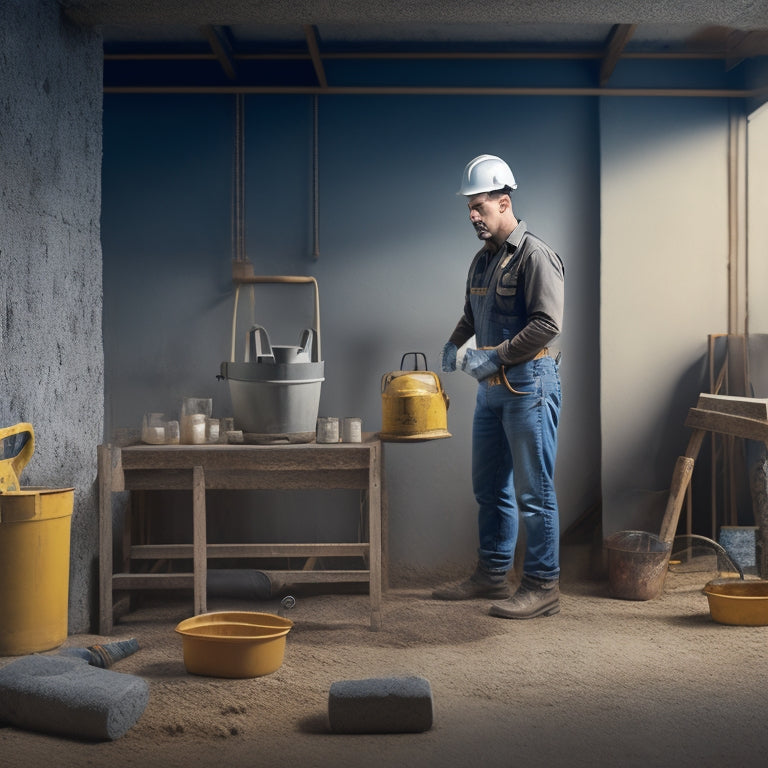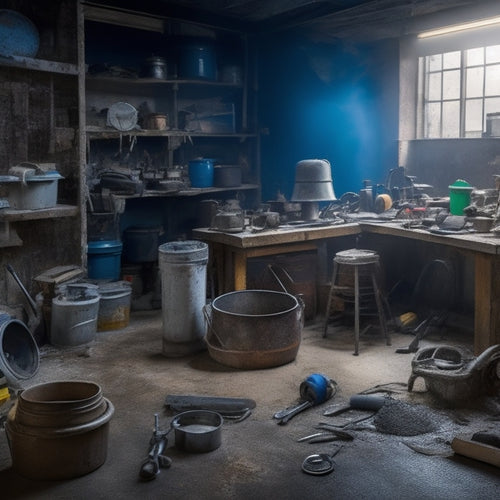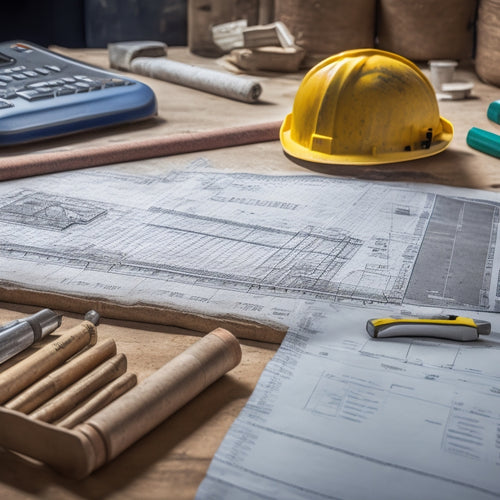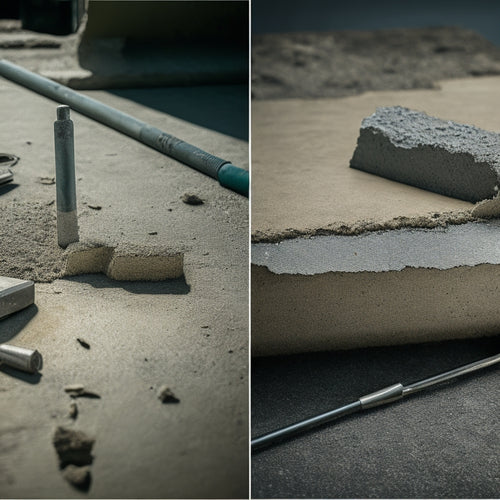
Must-Have Tools for Building a Concrete Block Wall
Share
You'll need a thorough set of specialized tools to guarantee a structurally sound and visually appealing concrete block wall, and missing even one important tool can compromise the entire project. From essential hand tools like sturdy trowels and levels to mixing and pouring concrete tools, block cutting and shaping tools, and measuring and leveling equipment, every tool plays a essential role. Additionally, safety gear, tamping and finishing tools, mortar mixing and application tools, and cleaning and finishing supplies are all must-haves. By having these tools at your disposal, you'll be well-equipped to tackle your project with confidence - and that's just the foundation of building a successful concrete block wall.
Key Takeaways
• Essential hand tools for laying concrete blocks include a sturdy trowel, level, string line, and jointer/jointing trowel for efficient and quality work.
• Mixing and pouring concrete requires a mixer, wheelbarrow, tamping tool, and safety precautions to ensure a strong and smooth finish.
• Block cutting and shaping tools, such as a masonry saw, grinder, and carbide-tipped chisel set, are necessary for precision and customization.
• Measuring and leveling equipment, including a laser level, digital measuring tape, and torpedo level, ensure accurate block placement and wall alignment.
• Safety gear, such as protective eyewear, gloves, and safety footwear, are crucial for protecting oneself from hazards and preventing accidents.
Essential Hand Tools for Laying
You'll need a sturdy trowel to scoop, spread, and level mortar, as it's the most frequently used hand tool when laying concrete blocks. A good quality trowel will make a huge difference in the efficiency and quality of your work.
Next, you'll require a level to guarantee your block wall is perfectly horizontal and vertical. A spirit level or a laser level will help you achieve precise alignment and plumbness.
Additionally, a string line and a line pin will aid in maintaining a straight course while laying blocks. Don't forget a jointer or a jointing trowel to finish the joints between blocks.
When it comes to masonry project planning, it's vital to have the right block wall materials on hand. Make sure you have an adequate supply of blocks, sand, and cement to avoid delays.
With these essential hand tools, you'll be well-prepared to tackle your concrete block wall project. By investing in quality tools, you'll save time, reduce frustration, and achieve professional-looking results.
Mixing and Pouring Concrete Tools
Two essential tools for mixing and pouring concrete are a mixer and a wheelbarrow or concrete buggy, which will enable you to efficiently combine and transport the concrete to the block-laying site. A mixer is necessary for achieving the right concrete mixing techniques, guaranteeing a consistent and strong mixture. You can opt for a gas-powered or electric mixer, depending on your preference and the size of your project.
| Tool | Description | Purpose |
|---|---|---|
| Mixer | Combines cement, sand, and water | Achieves concrete mixing techniques |
| Wheelbarrow/Concrete Buggy | Transports mixed concrete | Efficiently moves concrete to block-laying site |
| Tamping Tool | Compacts and levels concrete | Guarantees proper pouring methods |
When pouring concrete, it's vital to use the right pouring methods to avoid air pockets and guarantee a smooth finish. A tamping tool is essential for compacting and leveling the concrete as you pour it. By using these tools effectively, you'll be able to achieve a strong and durable concrete block wall that meets your expectations. Remember to follow the manufacturer's instructions for each tool and take necessary safety precautions to avoid accidents.
Block Cutting and Shaping Tools
With your concrete foundation in place, it's time to prepare the blocks that will make up your wall. This requires the right tools for cutting and shaping them to fit together seamlessly.
You'll need block cutting and shaping tools to guarantee a precise fit and a professional-looking finish. A masonry saw or a block cutter is essential for making clean cuts in your blocks. These cutting precision tools will help you achieve accurate cuts, reducing waste and saving you time.
For more intricate cuts or curved lines, you'll need a masonry grinder or a diamond blade saw. These tools will allow you to implement advanced block shaping techniques, giving your wall a unique and customized look.
A carbide-tipped chisel set is also a must-have for removing excess material and refining your cuts.
Don't forget a pair of safety gloves and goggles to protect yourself from debris and dust. With these tools in your arsenal, you'll be able to cut and shape your blocks with precision and confidence, guaranteeing a strong and durable wall that will last for years to come.
Measuring and Leveling Equipment
Accurate measurements and precise leveling are essential to building a sturdy and plumb concrete block wall, so it's important to have the right measuring and leveling equipment on hand.
You'll need tools that provide measuring accuracy and facilitate efficient leveling techniques. Here are three must-haves:
-
Laser Level: A laser level projects a level line or dot onto your work surface, guaranteeing precise horizontal and vertical alignment.
-
Digital Measuring Tape: A digital measuring tape provides accurate measurements up to 1/16 inch, making it ideal for measuring block lengths and wall dimensions.
-
Torpedo Level: A torpedo level is a compact, highly accurate level that's perfect for checking the level of individual blocks or small sections of the wall.
With these tools, you'll be able to achieve precise measurements and confirm your wall is perfectly level.
This is critical, as even minor deviations can lead to structural issues down the line. By investing in these essential tools, you'll set yourself up for success and assure a professional-looking finish.
Safety Gear for Masonry Work
Protecting yourself from the hazards of masonry work is vital, as the physical demands and heavy materials involved can lead to serious injuries if you're not properly equipped. You'll be handling heavy blocks, mixing mortar, and working with power tools, which can be hazardous if you're not careful. That's why it's important to invest in the right safety gear.
First and foremost, you'll need protective eyewear. Masonry work involves dealing with flying debris, dust, and other particles that can damage your eyes. Look for eyewear that provides 100% protection from UV rays and has anti-fog coatings to guarantee clear visibility.
You'll also need durable gloves to protect your hands from cuts, abrasions, and bruises. Choose gloves made from heavy-duty materials like leather or synthetic fabrics that can withstand the rigors of masonry work. They should also provide grip and traction to prevent slips and falls.
Tamping and Finishing Tools Needed
When you're building a concrete block wall, you'll need the right tamping and finishing tools to guarantee a strong and visually appealing structure.
You'll use these tools to compact the mortar and level the blocks, as well as to add the final touches to the wall's surface.
Tamping Techniques Explained
As you prepare to lay the foundation for a sturdy concrete block wall, mastering tamping techniques is essential to guarantee the blocks settle properly and the wall remains stable.
You'll need to compact the soil to create a solid base, and that's where tamping methods come in. There are various techniques to achieve ideal soil compaction, but here are three essential tips to get you started:
-
Use the right tool: Invest in a high-quality tamper, such as a plate compactor or a hand tamper, to make sure you're applying the necessary force to compact the soil.
-
Compact in layers: Divide the soil into layers, typically 2-3 inches deep, and compact each layer before adding more soil. This helps prevent settling and guarantees even compaction.
-
Check your progress: Regularly inspect the soil to make certain it's compacted evenly and to the desired density. This will help you identify any areas that need additional attention.
Finishing Touches Applied
You'll need a range of specialized tools to apply the finishing touches to your concrete block wall, guaranteeing a professional-grade finish that's both durable and visually appealing.
As you move on from tamping, it's crucial to focus on the details that elevate your wall's design aesthetics. To achieve a smooth, even surface, you'll require a jointer or a trowel to remove excess mortar and fill gaps between blocks. A level and a straightedge will help you ascertain the wall remains plumb and level.
For added wall insulation, you may need to apply a layer of insulation material, such as foam board or fiberglass batts, to the exterior of the wall. A utility knife or a specialized insulation cutter will make quick work of cutting the material to size.
Mortar Mixing and Application Tools
When building a concrete block wall, you'll need the right tools to mix and apply mortar efficiently.
You'll want to master the art of mixing mortar batches to the perfect consistency, then apply it consistently to guarantee a strong bond between blocks.
With the right techniques and tools, you'll be able to achieve professional-looking results.
Mixing Mortar Batches
To guarantee strong, uniform joints, mix mortar batches in a clean, sturdy wheelbarrow or mixing tub using a square-edged shovel or mortar hoe. This will help prevent contamination and guarantee consistent mortar consistency. Aim for a mix that's not too runny or too thick, as this can affect the block's adhesion and overall wall stability.
When it comes to batch timing, it's essential to get it right. Here are some key considerations:
-
Mix in small batches: Divide your mortar mix into smaller batches to maintain consistency and avoid waste.
-
Mix in the right order: Add sand, cement, and water in the correct sequence to achieve the right consistency.
-
Mix at the right pace: Mix the batch for the recommended 3-5 minutes to guarantee all ingredients are fully incorporated.
Efficient Trowel Techniques
With your mortar batches mixed to the right consistency, now it's time to focus on applying them efficiently using the right trowel techniques and tools. A comfortable trowel grip is essential for controlled mortar application.
Hold your trowel with a firm, but not overly tight, grip, allowing you to maneuver it smoothly. Experiment with different grip styles until you find one that feels natural.
Next, adjust your trowel angle to suit the block's texture and the mortar's consistency. For smooth blocks, hold your trowel at a 20- to 30-degree angle, while rougher blocks require a more shallow angle.
As you apply the mortar, maintain a consistent pressure, using your body weight to help spread it evenly. Pay attention to the trowel's edge, keeping it clean and free of excess mortar.
This will prevent uneven application and guarantee a professional finish. By mastering these fundamental trowel techniques, you'll be able to apply mortar efficiently, resulting in a strong, durable concrete block wall that meets your high standards.
Applying Mortar Consistently
You'll need a set of specialized tools to guarantee consistent mortar mixing and application, starting with a sturdy mixing bucket and a reliable trowel. Achieving mortar consistency is vital, as it directly affects the strength and durability of your concrete block wall.
To secure ideal results, focus on mastering these essential application techniques:
-
Proper mixing: Mix mortar to the correct consistency, neither too wet nor too dry, to guarantee it holds its shape when applied.
-
Consistent layering: Apply mortar in uniform layers, maintaining a consistent thickness to prevent weak points in the wall.
-
Precise placement: Place mortar precisely on the block, avoiding excess material that can lead to uneven joints and compromised structural integrity.
Cleaning and Finishing Supplies
Cleaning and finishing supplies are essential for removing excess mortar, achieving a uniform appearance, and protecting the wall from the elements.
You'll need a range of cleaning supplies to get the job done. Invest in a sturdy wire brush to scrub away excess mortar from the blocks and joints. A soft-bristled broom is also handy for sweeping away debris and dust. For more stubborn mortar stains, you can use a specialized cleaning solution or acid-based cleaner. Always follow the manufacturer's instructions and take necessary safety precautions when working with chemicals.
When it comes to finishing techniques, you'll want to evaluate the type of finish you're aiming for. Do you want a smooth, uniform look or a more textured, rustic appearance? Depending on your desired outcome, you may need to use specialized finishing tools, such as a jointer or a grinder.
Additionally, think about applying a sealant or waterproofing agent to protect your wall from the elements. By having the right cleaning and finishing supplies on hand, you'll be able to achieve a professional-looking finish that will last for years to come.
Frequently Asked Questions
Can I Use a Regular Drill for Mixing Concrete?
You're wondering if you can use a regular drill for mixing concrete. Sorry to break it to you, but that's not the best idea.
A regular drill lacks the power and torque needed for concrete mixing, which can lead to uneven mixing and a weaker final product.
Instead, you'll need a heavy-duty drill or a mixing drill specifically designed for concrete mixing, with a paddle or mixing bit attached, to get the job done efficiently and effectively.
Do I Need to Seal the Concrete Block Wall After Construction?
You're likely aware that concrete absorbs up to 30% of its weight in water, making moisture resistance essential.
After constructing your concrete block wall, sealing is a must to prevent water infiltration and damage.
You have several sealing options, including silane-based, siloxane-based, and acrylic coatings.
Choose a sealer that suits your climate and wall exposure, and apply it according to the manufacturer's instructions to guarantee a durable, long-lasting barrier against the elements.
How Do I Prevent Mortar From Staining My Tools?
When working with mortar, you'll want to prevent it from staining your tools. To do this, use a wire brush to scrape off excess mortar immediately after use.
Then, wash your tools with soap and water, and dry them thoroughly. Regularly oil your metal tools to prevent rust.
Additionally, consider using a mortar-specific cleaning solution for tough stains. By following these mortar cleanup techniques and tool maintenance tips, you'll extend the life of your tools and save time on cleaning.
Can I Build a Concrete Block Wall Without Mortar?
You're trying to build a wall without mortar, fundamentally trying to construct a castle without its foundation.
While it's not recommended, you can explore concrete block alternatives like interlocking blocks or dry-stacked walls with specialized systems.
However, you'll still need wall reinforcement techniques, such as rebar or fiber mesh, to guarantee stability.
Keep in mind, these methods may not be suitable for load-bearing walls or areas prone to high winds or seismic activity.
Do I Need a Permit to Build a Concrete Block Wall?
You're wondering if you need a permit to build a concrete block wall. The answer depends on your location and the wall's purpose.
Check with your local government to determine permit requirements, as construction regulations vary. Typically, permits are required for walls over a certain height or those that affect drainage, electrical, or plumbing systems.
Don't assume you're exempt - verify the regulations to avoid costly rework or even demolition.
Conclusion
As you stand back to admire your completed concrete block wall, remember that a chain is only as strong as its weakest link.
Each tool played an essential role in the construction process, and neglecting any one of them would have compromised the integrity of the entire structure.
By having the right tools for the job, you've guaranteed a solid foundation for your project.
Now, it's time to reap the rewards of your hard work and attention to detail.
Related Posts
-

7 Tools to Fix Damaged Concrete Floors
You're about to tackle that damaged concrete floor, and the right tools are essential for a successful repair. Start ...
-

5 Tips for Accurate Concrete Measurement Tools
To guarantee accurate concrete measurement, you'll want to calibrate your measuring tools regularly, choosing a frequ...
-

Top Tools for Concrete Adhesion Success
When it comes to concrete adhesion success, you'll need to wield the right tools and techniques to guarantee a strong...


